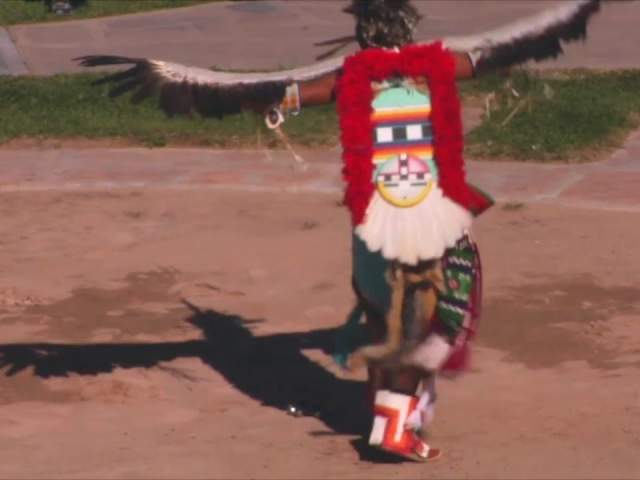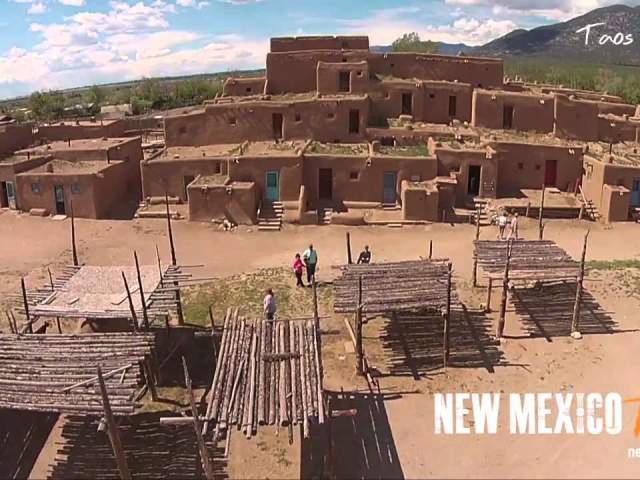Road Trip for True Native Culture Enthusiasts (9 stops - 717 miles)
The lingering and active presence of Native tribes in New Mexico plays a key role in making this state so special. Visit their historic homes and marvel at the mysteries of architectural achievements from nearly a thousand years ago. Revel in the sandstone features considered sacred. Then find your way to the still-inhabited Pueblos where dancers keep traditions alive in the form of native foods and dances on summer evenings.
Additional Road Trips:
Adventure | Cuisine | Architecture | Agriculture | Roadside Oddities | Route 66 | Families
A. Indian Pueblo Cultural Center
Browse the museum’s collection of Pueblo pottery, baskets, weaving, art, and turquoise jewelry to see the work from the 19 pueblos, sample indigenous cuisine in the Pueblo Harvest Café, and shop for contemporary Native art at Shumakolowa Native Arts, which promotes the work of established and emerging artists. Demos show artists at work, and regular Native Dances offer glimpses of how Pueblo communities have prayed, celebrated, and remembered their ancestors for centuries. The center also provides information about visiting pueblos, including feast days.
The pueblo at Acoma has been inhabited since the days of the Anasazi, the ancient residents who built cities at Mesa Verde and Chaco Canyon nearly 1,000 years ago and then mysteriously abandoned them. The sky city sits atop sandstone cliffs more than 300 feet high, and residents continue making their traditional pottery, known for its thin walls and geometric patterns, often painted in orange and black.

C. Zuni Pueblo
The Zuni people are famous for mosaic patterned inlay jewelry, needlework and fetish stone carving, which can be found in shops throughout the Southwest. The Zuni community features a variety of shopping and dining spots, plus service and convenience stores. Ten shops within the community sell Native American arts and crafts.

D. Gallup Nightly Indian Dances
Each evening from Memorial Day to Labor Day, members from area tribes fill the Gallup Courthouse Square, wearing colorful costumes and headdresses and sharing their traditional dances. The Zuni Pueblo, Navajo Diné Nation, Lakota Sioux, and San Juan Pueblo are among those that send dancers, often accompanied by music from drums, rattles, and flutes, and interpretation from tribal members on their traditions and meanings.

E. Shiprock
The spires of Shiprock, a volcanic plume, hover on the horizon for miles driving through northwestern New Mexico. The formation is considered sacred in the Navajo culture. The town named for the towering rock formation is among the larger Navajo Nation communities and hosts the annual Northern Navajo Fair and Shiprock Marathon and Relay.

F. Aztec Ruins National Monument
A half-mile self-guided trail explores this site’s 900-year-old Pueblo Great House and its more than 400 rooms, some of them stacked three stories tall, which centered on an open plaza. Original plaster walls, wooden roof beams, doors that exit from the corner of a room, and t-shaped doorways are still intact. The site’s Great Kiva, a subterranean ceremonial space more than 40 feet in diameter, has been reconstructed.
G. Chaco Culture National Historical Park
A network of pueblos spread through this canyon from Pueblo Bonita in such sharp alignment that hikers can reach distant ruins atop surrounding mesas, look back into the canyon and still spot the central pueblo’s walls. Marvel from a distance, or meander the pueblo’s interior chambers, passing through t-shaped doorways and up the stone stairways in structures made as long ago as 850. Petroglyphs can be found on the trails and even in the park’s campground, and its status as an International Dark Sky Park makes for outstanding stargazing.

Franciscan missionaries overtook this 700-year-old pueblo, built in San Diego Canyon near hot springs and led the construction of the massive, stonewalled San José de los Jemez church, compete with a unique octagonal bell tower, at the site in the 1620s. Traditional religious structures for the pueblo were destroyed as part of the conversion effort, and ongoing strife, possibly attributed to forced labor used to build the church, led the Spanish to leave it in 1640. The pueblo itself was abandoned during the Pueblo Revolt in 1680. A 1,400-foot interpretive trail winds through the historic sites.

I. Taos Pueblo
Native Americans have lived in the multi-story adobe buildings at Taos Pueblo for more than 1,000 years, and those structures remain largely unchanged from what Spanish explorers found here in 1540. Roughly 150 people still occupy the structures, which tradition dictates have no electricity or running water. They’re occupied most frequently during ceremonies. That both a church (rebuilt after original structure was destroyed during the 1680 revolt) and a kiva coexist is a token of the blended practices of Catholicism and the Pueblo religion.
BONUS ROUTE:
You’re on the Trail of the Ancients!
An official Scenic Byway, the Trail of the Ancients traverses the Colorado Plateau’s stunning landscape, linking archeological sites and passing landmarks significant to the area’s tribes. Take in the scope of the area long inhabited by nomadic tribes of the Navajo, Apache, and Ute, and tour the ruins of their ancient civilizations that once flourished here.







